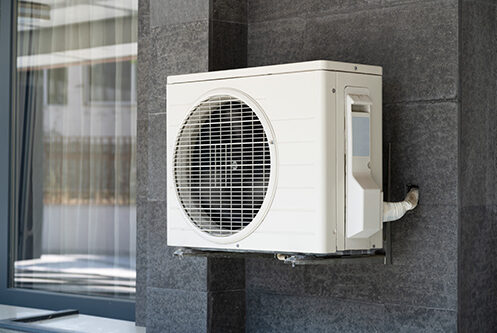When it comes to cooling your home, there are two main options: central AC units and ductless mini-splits. Both systems have advantages and disadvantages, and choosing the right one for your home can be daunting. Central AC units are the traditional option, but ductless mini-splits have gained popularity recently due to their energy efficiency and flexibility. Keep reading as we explore the differences between these two cooling systems and help you decide which one is best for your home.
How Central HVAC Systems Work
A central air conditioning (AC) unit is a system that cools the air in an entire building or house by removing heat and moisture from the indoor air. The cooling process begins when the house’s thermostat detects a rise in temperature above the desired set point, which triggers the AC system to start working.
The central AC unit consists of three main components: the compressor, the condenser, and the evaporator. The compressor is located outside the house and is responsible for compressing the refrigerant gas. The compressed gas is then sent to the condenser, which is also located outside the house. The condenser is responsible for releasing the heat from the refrigerant to the outside air, allowing the refrigerant to cool down.
Once the refrigerant has been cooled down, it is sent to the evaporator, which is located inside the house. The evaporator contains a series of coils that the refrigerant flows through. As the refrigerant flows through the coils, it absorbs heat and moisture from the indoor air. The cooled and dehumidified air is then blown back into the house through the ducts.
Advantages of Central AC Units
Whole-House Cooling
One of the primary advantages of a central AC unit is its ability to cool an entire house or building uniformly. With a central system, cooled air is distributed through ductwork to different rooms, providing consistent comfort throughout the space. This is particularly beneficial for larger homes or multi-story buildings where individual cooling units may not be sufficient.
Improved Indoor Air Quality
Central AC systems typically include air filters that help trap dust, pollen, and other airborne particles, improving indoor air quality. These filters remove contaminants, making the air cleaner and healthier to breathe. Some central AC units even have advanced filtration systems that can capture smaller particles, allergens, and even some bacteria or viruses.
Aesthetics and Space Efficiency
With the primary components situated outside the building, central AC systems maintain the structure’s architectural integrity while providing efficient cooling. This aesthetic advantage can be particularly important for homeowners who prioritize visual appeal or wish to maintain a consistent exterior appearance.
Disadvantages
Let’s explore some of the drawbacks of central AC units:
Complexity of Installation
The installation process for central AC units is complex and time-consuming. It involves installing ducts throughout the entire building, which can be disruptive and costly, particularly in existing structures. Additionally, the installation often requires professional expertise, adding to the overall expenses.
Inability to Zone Cooling
Central AC units cool the entire building simultaneously, which can be inefficient when specific areas require different temperature settings. For example, cooling an unoccupied room or a rarely used section of the building wastes energy and increases operating costs.
Energy Inefficiency
Central AC units can be less energy-efficient compared to alternative cooling options. The extensive ductwork in central systems may lead to energy losses due to leaks, insufficient insulation, or improper sealing. These inefficiencies can result in higher energy consumption and increased utility bills.
Limited Control and Flexibility
Central AC units typically have a single thermostat located in a central area, which may not accurately reflect the temperature in every room. This can lead to temperature variations throughout the building, with some rooms being too hot or too cold. Furthermore, adjusting the temperature in one part of the building can affect the entire system, limiting individual control and comfort preferences.
Incompatibility With Some Buildings
Retrofitting older buildings with central AC units can be challenging due to limited space for ductwork installation. Some older structures may not have the necessary infrastructure to accommodate a central AC system, requiring costly modifications or alternative cooling solutions.
Ductless Mini-Splits
Ductless mini-split systems, are efficient heating and cooling systems that provide zoned comfort control in residential and commercial spaces. They consist of two main components: an outdoor unit and one or more indoor units. The outdoor unit houses a compressor, condenser, and expansion valve, while the indoor unit(s) contains the evaporator coil and a fan.
The outdoor unit circulates the refrigerant through copper tubing that connects it to the indoor unit(s). The refrigerant absorbs heat from the indoor air and transfers it outdoors during cooling mode, while in heating mode, it absorbs heat from the outdoor air and transfers it indoors.
Advantages of Ductless Mini-Split
Here are some of the advantages ductless mini-splits offer: Zoned Comfort Ductless mini-splits provide zoned comfort, meaning you can independently control the temperature in different areas or rooms of your home. Each indoor unit has its own thermostat, allowing you to adjust the temperature according to individual preferences, optimizing comfort and energy efficiency.
No Ductwork
Unlike traditional HVAC systems, ductless mini-splits do not require ductwork to distribute conditioned air. Instead, they deliver air directly into the room from the indoor unit. This eliminates the energy losses associated with ducts, such as leaks, heat transfer, and inefficient airflow, resulting in improved energy efficiency.
Easy Installation
Installing ductwork can be complex and costly, but ductless mini-split systems are relatively easy to install. The indoor units are mounted on walls or ceilings, and the outdoor unit can be placed outside the building. Since only a small hole is needed to connect the indoor and outdoor units, installation is less disruptive and time-consuming, making it a convenient option for retrofitting existing buildings or adding climate control to new constructions.
Flexibility
Ductless mini-split systems offer flexibility in terms of design and usage. With various indoor unit types, such as wall-mounted, ceiling cassette, or concealed ducted units, you can choose the option that best suits your space and aesthetic preferences.
Disadvantages of Ductless Mini-Split
Here are some of the drawbacks associated with ductless mini-splits:
Higher Upfront Cost
One of the primary disadvantages of ductless mini-split systems is their higher initial cost compared to traditional HVAC systems. The cost of purchasing and installing multiple indoor units and the outdoor condenser can be more expensive than installing a central ducted system.
Aesthetics
The indoor units of ductless mini-split systems are visible within the room as they need to be mounted on the walls or ceilings. This can be a concern for some homeowners who prefer a more discreet HVAC system.
Maintenance and Cleaning
While ductless mini-splits are generally low maintenance, regular cleaning of the filters and indoor unit coils is necessary to ensure optimal performance. Neglecting routine HVAC maintenance can lead to decreased efficiency, reduced lifespan, and potential issues with indoor air quality.
Call Professionals Today!
At Christian Brothers Air Conditioning Plumbing Electrical, we take pride in providing top-notch plumbing, cooling, heating, and electrical services to residents in Glendale, AZ, and the surrounding areas. Our team of skilled professionals is dedicated to delivering exceptional service and ensuring your complete satisfaction. Whether you’re dealing with a plumbing emergency, need assistance with your cooling system, require heating repairs, or have electrical needs, we are here to help. Contact Christian Brothers Air Conditioning Plumbing Electrical today to schedule an appointment.










